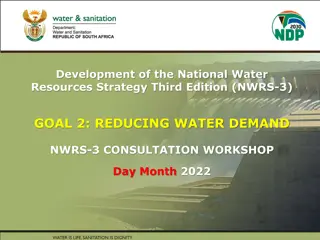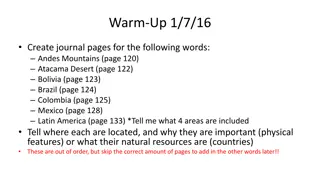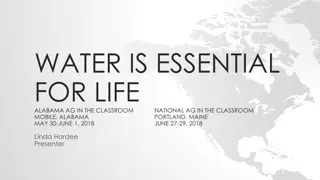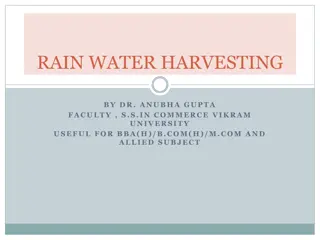Human Impact and Water Resources in South America
Understanding the importance of water resources in human development, this content explores how people in the past controlled water in South America, particularly along the coast. It discusses the balance between saltwater and freshwater resources, the impact of geography on climate, and the role of nutrient-rich upwelling in providing food for early societies. Through examples like Caral in Peru, the connection between fresh water sources and societal development is highlighted, emphasizing the reliance on both ocean resources and river valleys for sustaining early civilizations despite challenges like El Niño.
Download Presentation

Please find below an Image/Link to download the presentation.
The content on the website is provided AS IS for your information and personal use only. It may not be sold, licensed, or shared on other websites without obtaining consent from the author. Download presentation by click this link. If you encounter any issues during the download, it is possible that the publisher has removed the file from their server.
E N D
Presentation Transcript
HUMAN IMPACT FROM CLIMATE CHANGE The importance of water and water resources Salt water resources vs. fresh water How people in the past controlled the water
Wet and green Dry and brown Understanding geography, water sources and climate is critical to understand human development in the past and today. In South American, the Andes Mountains on the west stopped the movement of clouds from the east. East of the mountains it is wet. West of the Andes it is extremely dry.
Despite the dryness, the west coast of Peru could farm along river valleys and could find rich ocean resources from upwelling. Upwelling is deep nutrient rich water coming to the surface. The upwelling off the western coasts of Ecuador and Peru was due to wind movement and movement of the earth and the continents.
Nutrient rich water from the upwelling provides food for lots of fish. Fish provides resources for humans now and in the past
The earliest complex societies developed in South America along the coast. To have a complex society, there needs to be a surplus of food. Surplus for these early complex societies came from the sea so the biggest sites were close to the coast. Sechin Bajo ~3500 BC --
The ocean provided a lot of food, but people had to live near fresh water for drinking. Fresh water in coastal Peru could only be found near river valleys which brought water from the mountains.
Caral 3000 BC Complex of pyramids -- similar in time to earliest pyramids of Egypt Largest is size of 4 football fields
During El Nino not only are there less fish in the coastal waters but also the change in wind patterns moves warm ocean water toward the land causing strong rains. We can see extreme El Nino events in archaeology by sites that are covered or partially destroyed by the torrential waters.
Climate change can cause disastrous floods or long term droughts People in the past would manage water to avoid disaster.
ENGINEERING AND WATER Native South Americans created raised fields to get more water to their fields Raised fields provided water to crops but also provided a micro environment for fish and birds and other organisms to live. The muck produced in the canals would be used as natural fertilizer for the crops. Water would absorb energy from sun during the day and would keep the raised fields from freezing at night.
Much of the Andes land is too steep to farm. People put terraces on fields to create level fields to control water for the crops and to prevent erosion.
Ancient Romans made aqueducts to transport water We make large dams and reservoirs (Hoover dam)
To move and control water people need to work with the principle of gravity. Water always flows down.
Only the precipitation falling on the light green area (purple arrows) would flow to the river in the center.
Now you create a landscape! Show how water moves on your landscape using marbles.
Next, prepare for drought or control for erosion. Build canals, dams, reservoirs, terraces or raised fields to control the water. Use marbles to prove water goes where you wanted.























